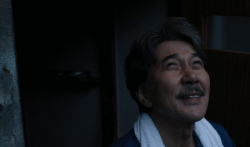Rather than randomly hanging beautiful pictures of beautiful dancers, the National Portrait Gallery examines the history of dance as a visual art form in its exhibit Dancing the Dream, on display until July 14, 2014. The exhibit finds its strength in discussing the historical significance of dance on American cultural identity. At the same time, this focus on history becomes overly intellectual at the price of beauty, which is where the exhibit finds its weakness.
The museum begins the exhibition with a series of historical portraits of dancers and vintage posters for their shows from the early 20th century. All of the dancers and choreographers in this first room, “Broadway and the American Dream,” were moving away from classical ballet and stepping into modern dance.
Perhaps the most striking image, one that sets the tone for the exhibit, is the first, a lithograph of a thin black woman, reminiscent of some of Mattisse’s figures, wearing only a skirt made of bananas. The description introduces the viewer to Josephine Baker, a dancer who travelled to Paris in the ‘20s to work in the then highly popular “negro vaudeville.” She soon became wildly famous and worked to curate her public image as exotic, actually wearing banana skirts and even walking a pet leopard down the streets of Paris.
While this print is beautiful and interesting alone, understanding its history—the racism of 1920s America and Europe—is entirely essential to truly appreciating the work and the dancer.
And this is where the exhibit overall falls short. Without reading the small-print descriptions next to sometimes unimpressive photos or prints, the viewer loses sight of their importance. If a visitor is not willing to read each description in detail, the room seems unimpressive and somewhat disorganized. Only two of six rooms and a hallway had accompanying videos. Considering the most important aspect of dance is movement itself, it’s surprising that these videos aren’t more prominent and thorough.
Those of us who are not familiar with the history of dance might become quickly impatient with Dancing the Dream. The lack of videos can be frustrating. A photo description calls one of Eleanor Powell’s dances “one of the most powerful ever filmed.” It does not follow that this dance is not shown in any of the videos.
The organization and history embedded in this exhibit redeem some of these logical flaws and sometimes not so exciting (okay, boring) visual material. The exhibit moves from early Broadway/Vaudeville to Hollywood, where it brings in some familiar movie posters, like Dirty Dancing and Black Swan. These are strategically placed in one room with video, where the curator clearly understood that visitors would not pay much attention to detailed descriptions when John Travolta’s gyrating hips play on a loop in the background.
The next rooms move into modern American dance, including Alvin Ailey’s famous dance theater and the rise of American ballet. These rooms are both visually and historically stimulating, but the last room, “Choreography goes POP!” is the most inventive.
While it contains posters of Justin Timberlake and Beyoncé, this room highlights the exhibit’s wide historical and cultural scope. An entire wall of the room has QR codes, linking to YouTube videos of dance renditions and flash mobs. The use of QR codes piques guests’ interest and highlights the effect of technology and media on dance and dance culture. Dance is no longer strictly for high-class performances and skilled dancers. This last statement serves to highlight just how far American dance has come since the first steps of modern dance in the early 20th century.
While this exhibition has depth in its history and factual evidence, it fails to indulge visitors in what they likely went to the exhibit to see: the sheer power and beauty of dance. There is a reason Degas lost himself in the magic of ballet, and this exhibit ignores that emotional force.
National Portrait Gallery
8th and F Streets, N.W.
11:30 a.m.-7:00 p.m. daily
npg.si.edu/exhibit/dance




